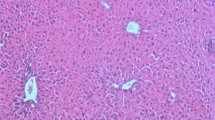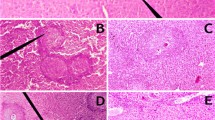Abstract
In this article, two strains of mice BALB/C and C57 were infected with Egyptian strain of Schistosoma mansoni. BALB/C mice appeared to harbor fewer parasites than did C57 mice. The hepatic and intestinal tissues of C57 mice were loaded with more eggs than that of BALB/C mice. Regardless the strain of mice, the number of eggs per gram of liver tissues was higher than in the intestinal tissues. Some biochemical parameters were measured in the liver of infected and non-infected mice; a significant decrease in the activities of alkaline phosphatase, catalase, glutathione-s-transferase, glutathione, and total lipids of infected mice compared to their matched control were observed. However, there was a significant increase in malondialdehyde level of infected mice compared to their matched group. Detailed discussion on the parasitological and biochemical differences between the two strains was presented.
Similar content being viewed by others
References
Aebi H (1984) Catalase in vitro. Methods Enzymol 105:121–126
Armstrong RN (1997) Structure, catalytic mechanism and evolution of the glutathione transferases. Chem Res Toxicol 10:2–18
Bilzer M, Gerbes AL (2000) Preservation injury of the liver: mechanisms and novel therapeutic strategies. J Hepatol 32:508–515
Boissier J, Moné H (2000) Experimental observations on the sex ratio of adult Schistosoma mansoni, with comments on the natural male bias. Parasitology 121:379–383
Boissier J, Moné H (2001) Relationship between worm burden and male proportion in Schistosoma mansoni experimentally infected rodents and primates. A meta-analytical approach. Inter J Parasitol 31:1597–1599
Boissier J, Morand S, Moné H (1999) A review of performance and cycle. Parasitology 119:447–454
Cheever AW (1968) A quantitative post mortem study of Schistosoma mansoni in man. Am J Trop Med Hyg 17:38–64
Cheever AW, Macedonia JG, Mosimann JE, Cheever EA (1994) Kinetics of egg production and egg excretion by Schistosoma mansoni and S. japonicum in mice infected with a single pair of worms. Am J Trop Med Hyg 50(3):281–295
Cheever AW, Lenzi JA, Lenzi HL, Andrade ZA (2002) Experimental models of Schistosoma mansoni infection. Mem Inst Oswaldo Cruz 97(7):917–940
Chitsulo L, Engels D, Montresor A, Savioli L (2000) The global status of schistosomiasis and its control. Acta Trop 77:41–51
Draper HH, Hadley M (1990) Malondialdehyde determination as index of lipid peroxidation. Methods Enzymol 186:421–431
Eaton DL, Bammler K (1999) Concise review of the glutathione S transferases catalytic activity. Crit Rev Biochem 23:283–336
Fattman CL, Schaefer LM, Oury TD (2003) Extracellular superoxide dismutase in biology and medicine. Free Radic Biol Med 35:236–256
Gregorevic P, Lynch GS, Williams DA (2001) Hyperbaric oxygen modulates antioxidant enzyme activity in rat skeletal muscles. Eur J Appl Physiol 86:24–27
Habig WH, Jakoby WB (1981) Assays for differentiation of glutathione S-transferases. Methods Enzymol 77:398–405
Hotez PJ, Molyneux DH, Fenwick A, Ottesen E, Ehrlich S, Sachs JD (2006) Incorporating a rapid-impact package for neglected tropical diseases with programs for HIV/AIDS, tuberculosis, and malaria: a comprehensive pro-poor health policy and strategy for the developing world. PLoS Med 3:102
Incani RN, Morales G, Cesari IM (2001) Parasite and vertebrate host genetic heterogeneity determine the outcome of infection by Schistosoma mansoni. Parasitol Res 87(2):131–137
Jaeschke H (2000) PReactive oxygen and mechanisms of inflammatory liver injury. J Gastroenterol Hepatol 15:718–724
Jones JT, Breeze P, Kusel JR (1989) Schistosome fecundity: influence of host genotype and intensity of infection. Int J Parasitol 19(7):769–777
Kassim OO, Cheever AW, Richards CS (1979) Schistosoma mansoni: mice infected with different worm strains. Exp Parasitol 48:220–224
Ketterer B (1998) Glutathione S-transferases and prevention of cellular free radical damage. Free Radic Res 28:647–658
King PRN, King EI (1954) Estimation of plasma phosphatase by determination of hydrolyzed phenol with amino-antipyrine. J Clin Pathol 7:322–326
Knight JA, Anderson S, Rawle JM (1972) Chemical basis of the sulfophosphovanillin reaction for estimation total serum lipids. Clin Chem 18:199–202
Kolodziejczyk L, Siemieniuk E, Skrzydlewska E (2005) Antioxidant potential of rat liver in experimental infection with Fasciola hepatica. Parasitol Res 96:367–372
Kuntz RE, Huang TC, Moore JA (1977) Patas monkey (Erythrocebus patas) naturally infected with Schistosoma mansoni. J Parasitol 63:166–167
LoVerde PT (1998) Do antioxidants play a role in schistosome host parasite interactions? Parasitol Today 14:284–289
Mannervik B, Danielson UH (1988) Glutathione transferases-structure and their significance to toxicology. Toxicol Sci 49:156–164
McCord JM (1993) Human disease, free radicals, and the oxidant/ antioxidant balance. Clin Biochem 26:351–357
Michiels C, Raes M, Toussaint O, Ramacle J (1994) Importance of glutathione peroxidase, catalase and Cu, Zn-SOD for cell survival against oxidative stress. Free Radic Biol Med 17:235–248
Nielsen F, Mikkelsen BB, Nielsen JB, Andersen HR, Grandjean P (1997) Plasma malondialdehyde as biomarker for oxidative stress: reference interval and effects of life-style factors. Clin Chem 43:1209–1214
Ohkawa H, Ohishi N, Yagi K (1979) Assay for lipid peroxidation in animal tissues by thiobarbituric acid reaction. Anal Biochem 95:350–358
Oliver L, Stirewalt MA (1952) An efficient method for exposure of mice to cercariae of Schistosoma mansoni. J Parasitol 38:19–23
Prins HK, Loose JA (1969) Glutathione. In: Yunis JJ (ed) Biochemical methods in red cell genetics. Academic, London, pp 126–129
Rajasekaran S, Sivagnanam K, Subramanian S (2005) Antioxidant effect of aloe vera gel extract in streptozotocin-induced diabetes in rats. Pharmacol Rep 57:90–96
Saoud MFA (1966) The infectivity and pathogenicity of geographical strains of Schistosoma mansoni. Trans R Soc Trop Med Hyg 60:585–600
Sayed AA, Cook SK, Williams DL (2006) Redox balance mechanisms in Schistosoma mansoni rely on peroxiredoxins and albumin and implicate peroxiredoxins as novel drug targets. J Biol Chem 281:17001–17010
Smithers SR, Terry RJ (1965) The infection of laboratory hosts with cercariae of Schistosoma mansoni and the recovery of the adult worms. Parasitology 55:695–700
Author information
Authors and Affiliations
Corresponding author
Rights and permissions
About this article
Cite this article
Bin Dajem, S.M., Mostafa, O.M.S. & El-Said, F.G. Susceptibility of two strains of mice to the infection with Schistosoma mansoni: Parasitological and biochemical studies. Parasitol Res 103, 1059–1063 (2008). https://doi.org/10.1007/s00436-008-1092-3
Received:
Accepted:
Published:
Issue Date:
DOI: https://doi.org/10.1007/s00436-008-1092-3




